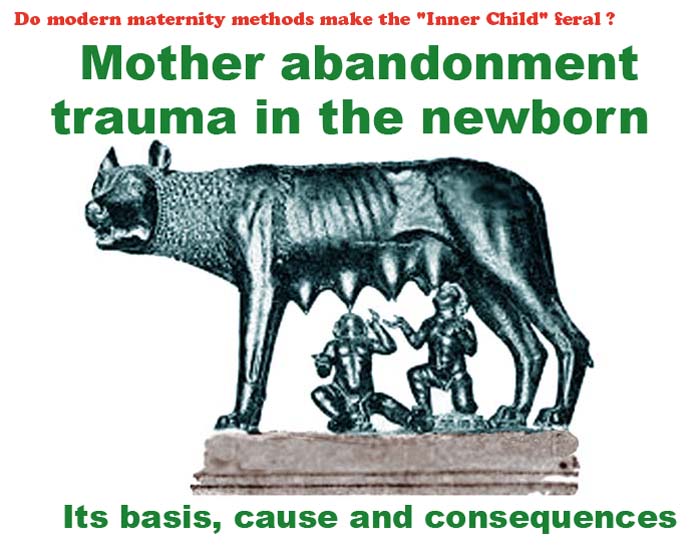|

|
| By Graham Gorman |
From the 1940’s onwards, the great-grandparents of today’s Obstetricians took over and hospitalised the otherwise natural process of birthgiving and which was previously almost entirely home-based. The hospital based birth rate consequently rose from some 10 per cent., in 1940, to about 50 per cent., in 1960 and since 1980, to at least 98 per cent..(Tew, 1998)
There were various reasons for this takeover but this article concentrates on the unfortunate consequences to the wellbeing of the babies, children and ultimately of adults and society.
From 1985 – 1995, I undertook a large scale independent research (Gorman, 1997) which was only intended to resolve the vexed issue, within academic psychology, of whether veridical unconscious memories can exist or not. I ran the research with a professional engineer’s mindset. |
From the 1940’s onwards, the great-grandparents of today’s Obstetricians took over and hospitalised the otherwise natural process of birthgiving and which was previously almost entirely home-based. The hospital based birth rate consequently rose from some 10 per cent., in 1940, to about 50 per cent., in 1960 and since 1980, to at least 98 per cent..(Tew, 1998)
There were various reasons for this takeover but this article concentrates on the unfortunate consequences to the wellbeing of the babies, children and ultimately of adults and society.
From 1985 – 1995, I undertook a large scale independent research (Gorman, 1997) which was only intended to resolve the vexed issue, within academic psychology, of whether veridical unconscious memories can exist or not. I ran the research with a professional engineer’s mindset. |
 |
We like to know how things work, down to the last nut and bolt. I was also not confined by any existing prejudices. My research involved 404 adults among 1200 who presented to my professional hypnotherapy practice.
That research did confirm that such unconscious memories do exist and quite unexpectedly it also revealed compelling evidence that hospital based obstetric birthing practices were causing up to 88 per cent., of babies to leave hospital psychologically traumatised, potentially for life. This compared with a trauma rate of 22 per cent., for home-born subject. |
In the 1990’s the level of consequences in adults was not high enough for the full significance of the research results to be realised. But now, forty years after the hospitalised birthgiving rate has been over 98 per cent., the effects of the birth traumas are all too evident in both individuals and society.
The most publicly obvious consequence is the alarming increase in all types of aggression by men against females.
The obstetric intrusion into the natural act of birthgiving is causing an abject terror in the newborn that mother has abandoned it and so its continued life is in peril.
This terror is accompanied by a feral level anger and hate of mother plus a sense of unworthiness. The universal long-term effect is an unconscious anxiety that mother’s love is not sincere. This fear is mostly unjustified and the later reactions to it are thus irrational. They are mental health and behavioural problems in children, which continue into adulthood, too often of a violent nature.
|
 |
Graham Gorman
has been involved with hypnotherapy for more than 35 years following his retirement as an engineering scientists and technical director with Racal Electronics.
He first trained with the National College of Hypnosis and Psychotherapy and was a member of the National Register of Hypnosis and Psychotherapy from 1982 until 2016 and was a member of its Governing Council for eight years.
In addition he was a member of UKCP from its inception to 2001.
He
managed his own hypnotherapy practice between 1985 until 2000 during which time he also conducted extensive research.
Early results of his studies were carried by the European Journal of Clinical Hypnosis in 1997.
|
The basis of abandonment trauma
The subjects in my research revealed a previously unidentified, feral level Instinct for Survival.
We members of the human race have been reluctant to admit to the remaining extent of our relationship with the 'lower animals'. It is also largely believed by the psychological and medical professions that we cannot retain memories of events earlier than some three years of age because our forebrains are not sufficiently developed until then, to process and retain episodic autobiographical memories. This belief is entirely correct as confirmed by universal experience. (McNally, 2003).
However, my research subjects revealed another memory asset located in our hind (reptilian) brain and associated with the now revealed feral level Instinct for Survival.
 |
A natural feature of the hypnoregression technique I used enabled the adult subjects to speak for themselves. They were able to recall birth related traumatic events with remarkable detail (Chamberlain, 1986). Such recalls may in principle be entirely false and/or imposed or be totally imaginary or substantially correct.
The only recalled early memories I ever accepted or quote have been independently confirmed by the subjects’ mothers. Further, every subject’s birth trauma was based on the separation induced suspicion of the sincerity of mother’s love. Finally the recalled memories also accorded with the later problems of the subjects. |
Our hind brain is already acknowledged as the controlling seat of heartbeat, which it has initiated as early as two weeks after conception and of breathing as well as of emotions. (Interestingly it is also associated with our survival need, but only in undetailed terms.)
Immediately after birth, the newborn can take its first breath, can move its tongue and swallow and take in its first oral nutrition. All its senses are already functioning to a sufficient degree and it can move its limbs. Nature has equipped all animals, as Hauser (Hauser,2000) realised, with a ‘starter toolkit’ including every asset necessary to enable the newborn to begin a life independent of its mother – and we are the latest evolutionary product of nature’s animal species.
Our reptilian brain part is nature’s equivalent of the bios which prepares our computers to perform all their required tasks.
The survival instinct is an awesomely powerful urge to achieve continued life and at birth it recognises mother as the provider and sustainer of that life, ‘No mother, and no life!’ If the newborn perceives that mother has abandoned it, the resulting rage is feral in intensity. Until the time of birth the baby has had the physical lifeline of the umbilical cord with mother. Seemingly, nature has not provided human foetuses with any foreknowledge that they can survive without a continuous intimate connection with mother. Any break in this is perceived as abandonment and impending death. Consequently, newborns have no pre-acquired ability to confidently wait for a future response to any need. Immediacy is their urgent demand. That being separated from mother does not mean abandonment has to be learned by gradual experience.
This newly identified feral level Instinct for Survival combined with the perception of abandonment by mother, is the ultimate root of neonatal trauma
The cause of abandonment trauma
The terrors my subjects’ recalled made it clear that a break of more than a few seconds in an intimate connection with mother caused a high state of alarm and anger. Newborns require to be lying at their mother’s breast before their umbilical cord is cut. The common hospital procedure of early cutting of the cord and also immediately removing the baby for wiping down, sucking out and checking is well intentioned but catastrophic for the baby’s trust in mother for a continuation of its life.
Practical causes of abandonment trauma.
Unwanted pregnancy and attempted abortion.
Caesarean births.
Very slow birth or very quick birth.
Use of forceps or ventouse.
Near strangulation by umbilical cord.
Early cutting of umbilical cord
Baby not left lying with mother until settled before brief and nearby removal for any purpose.
Retention in a nursery except for feeding.
Long-term separation for premature birth treatment.
Some of these examples are unavoidable, so can also occur in home-birthing and were the main causes of the 22% trauma rate there
The consequences
Immediate
N.B. All phrases within quotation marks are actual quotes from the research subjects’ recalls of their feral level memories. The mechanism of these recalls is explained below.
When the mother welcomes her newborn with all the love and affection that new mothers mostly do, the traumatised baby is confused, ‘You seem to love me mother but can I trust you?’ This doubt has immediate and long term consequences explained below.
Apart from the terror and the hate and anger, ‘I have a right to live’, there was loss of self worth, ‘ I can’t be good enough for you mother’, self blame, ’Have I hurt you mother?’, Do you not want me mother?’
As a result of thee fears, the baby can resist bonding with mother.
This feral suspicion over the sincerity of mother’s love and the newborn’s associated anxieties are the final step toward all subsequent consequences. |

Secondary Traumas
These traumas are the vehicles that carry the birth trauma through to adulthood. They can also occur throughout life from any event inducing a subconscious memory of abandonment or rejection.
The individual, unconsciously, takes them as confirming the original threat and they cause an immediate anxiety. The event is then memorised, att feral level, as a Secondary Trauma.
Common causes of Secondary Traumas.
Slow maternal reaction to crying for attention.
Being put to bd at night and left. (Having recently emerged from a dark place babies can be terrorised by being returned to one and then left by mother.)
Non-tactile parenting.
Birth of a sibling.
Put to baby care especially before three years old.
Mother not returning home at expected time
First day at school.
Severe rebukes.
Mother in hospital.
Change of school
Parents’ divorce.
Leaving home for university or the like.
Behavioural consequences.
Children suffer a variety of behavioural and mental problems. Bad behaviour can, paradoxically be an attempt at reassurance that mother’s love is sincere, (‘If you love me when I’m bad mother, perhaps you really love me’.). Unfortunately mother is more likely to remonstrate, which only increases the child’s suspicion.
Common childhood consequences are:
Prolonged bed-wetting;
Few friends;
Study difficulty;
Mood swings;
Panic attacks
Low confidence and depression and in extreme cases, panic attacks and less frequently and in older children, a suicide threat.
The arrival of puberty is a highly significant stage in the consequences of neonatal trauma. It heralds the unstoppable approach to adulthood, whereas the greatest (unconscious) wish of a significantly traumatised child is to relive childhood and to not be feeling abandoned the next time.
All abandonment trauma consequences become more apparent and the increasing anxiety and unconfidence can lead to increased behavioural problems which are a major contributor to ‘teenage angst’.
The wish to retain childhood can cause a reluctance to contemplate adult issues such as leaving home, university, or careers. In severe cases, food limiting or, in girls, lack of periods are very clear signs of the urge to cling to childhood and also to achieve some control over their own lives.
A major consequence of puberty is that the suspicion about the sincerity of mother’s apparent love spreads to all women. The worst effect is on males. It is the cause of much promiscuity, (‘This one seems to love me but what about all the others?) and of aggression towards the female partner, (‘You don’t love me. I hate you.’) and abuse of children of the partnership, (‘You love them more than you love me’.) and opportunistic aggression to any female.
Trigger Traumas
Some life events evoke a particularly intense reminder of the original abandonment trauma and result in a long-term, overt mental health problem, such as depression, phobias or aggression. A surprising number of physical problems are also reactions to a trigger trauma.
Common typical Triggers.
Loss of mother or very close relative or friend.
Giving birth.
Male rejected by girl-friend or adult partner.
Partner of traumatised male becoming pregnant.
Loss of job.
Retirement.
An extreme consequence can follow the trigger trauma of a male’s rejection by a girl-friend or partner. This is the root of stalking – a dangerous mindset on the stalkers part which can lead even to severe harassment, physical abuse or ultimately to murder of the ex partner and even of the partner’s children. Stalking is the consequence of a serious irrational mental state and needs to be taken much more seriously by the relevant forces and authorities.
Summary
The discovery of the previously unidentified feral level instinct for survival and of the consequences of the newborn’s perceived abandonment by the life-giving mother have revealed the root cause and life history of many mental health states and of much irrational and violent adult behaviour.
It has also identified that the dominance of hospital based birth-giving and the associated obstetric practices are the root cause of the greatly increased levels of these consequences in recent years.
References
N.B. In view of the wide readership these papers will have I am providing only the most relevant references. Because my research was into uncharted and controversial territory and using non mainstream methods, there is very little supporting literature anyway. I can provide a further reading list to interested individuals.
Chamberlain, D.B. (1986) Reliability of Birth Memories: Evidence from mother and child pairs in hypnosis. Journal of the American Academy of Medical Hypnoanalysts, I(2), 89-98.
Gorman, G. (1997) Unconscious Memory, Fact or Fiction. The European Journal of Clinical Hypnosis, vol.4, no.3, pp.146-153.
Hauser, M. (2000) What Animals Really Think, London, Penguin Books,
Home Office UK.(2018) Police recorded crime Data.
McNally, R. J. (1999) Remembering Trauma. London: Harvard University Press.
Tew, M. (1998) Safer Childbirth? London, Free Association Books Ltd.
|
References
N.B. In view of the wide readership these papers will have I am providing only the most relevant references. Because my research was into uncharted and controversial territory and using non mainstream methods, there is very little supporting literature anyway. I can provide a further reading list to interested individuals.
Chamberlain, D.B. (1986) Reliability of Birth Memories: Evidence from mother and child pairs in hypnosis. Journal of the American Academy of Medical Hypnoanalysts, I(2), 89-98.
Gorman, G. (1997) Unconscious Memory, Fact or Fiction. The European Journal of Clinical Hypnosis, vol.4, no.3, pp.146-153.
Hauser, M. (2000) What Animals Really Think, London, Penguin Books,
Home Office UK.(2018) Police recorded crime Data.
McNally, R. J. (1999) Remembering Trauma. London: Harvard University Press.
Tew, M. (1998) Safer Childbirth? London, Free Association Books Ltd. |
| |
|
|
|